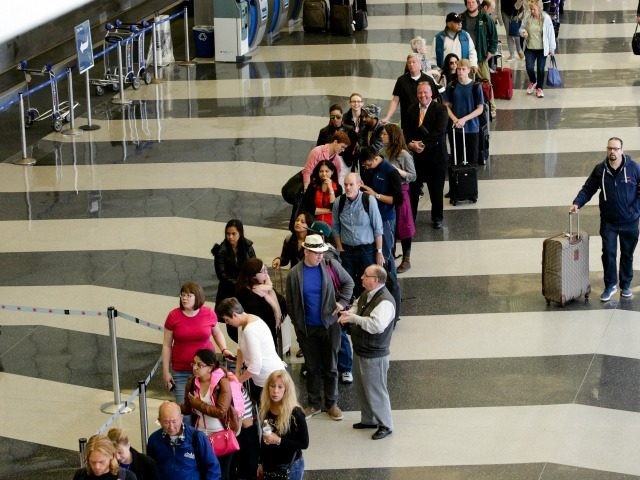Federal inspectors charged with keeping America’s transportation system safe only spend “half their working hours” doing work, reveals an audit by the Government Accountability Office (GAO), Congress’ watchdog arm.
“We found that between fiscal years 2013 and 2017, inspectors spent about half their working hours fulfilling work plan requirements,” reports the GAO, referring to surface inspectors from the U.S. Transportation Security Administration (TSA).
The GAO explains:
Surface inspectors conduct a variety of activities to implement TSA’s surface transportation security mission, including (1) regulatory inspections for freight and passenger rail systems, (2) regulatory TWIC inspections, and (3) non-regulatory security assessments and training which surface transportation entities participate in on a voluntary basis.
Despite the reportedly low-performance level, inspectors from TSA, a component of the U.S. Department of Homeland Security, may be exceeding expectations.
“The [inspectors’] work plan requirements are designed to take up about one-third of inspectors’ available working hours, with the expectation that the other two-thirds of inspectors’ time will be used for related activities,” notes the report.
GAO’s audit comes in the wake of the New York City subway attack attempted by a chain migration jihadi from Bangladesh allegedly inspired by the Islamic State (ISIS/ISIL).
The auditor warns:
The global terrorist threat to surface transportation—freight and passenger rail, mass transit, highway, maritime and pipeline systems—has increased in recent years, as demonstrated by the 2017 London vehicle attacks and a 2016 thwarted attack on mass transit in the New York area. TSA is the primary federal agency responsible for securing surface transportation in the United States.
GAO notes that when the TSA inspectors are working, they are spending more time guarding against low-risk threats than higher-risk ones.
The report reveals:
In fiscal year 2016, the last full year for which data on inspectors’ activities in the surface modes was available, surface inspectors reported spending more than twice as much time on the lowest risk surface transportation mode according to TSA risk assessments than on the highest risk surface transportation mode.
…
Inspectors reported spending between 35 and 45 percent of their time on the lowest risk mode between fiscal year 2013 and fiscal year 2016—the most time spent on any surface mode.
The TSA did attempt to implement improvements in 2017, but they have failed to kick in.
GAO notes:
In fiscal year 2017, TSA fulle implemented a new risk mitigation program … intended to focus time and resources on high-risk surface transportation entities and locations. However, GAO found that TSA has not identified or prioritized these high-risk entities and locations.
In a recently published audit, Congress’ watchdog describes surface inspectors’ duties as:
Regulatory Inspections: Surface inspectors enforce freight rail, passenger rail, and maritime security regulations. GAO found that, according to TSA data, surface inspectors reported spending approximately 20 percent of their time on these activities from fiscal years 2013 to 2017.
Non-regulatory assessments and assistance: Surface inspectors conduct voluntary assessments and provide training to surface transportation entities, among other things. GAO found that, according to TSA data, inspectors reported spending approximately 80.
According to the GAO, more than 16 years after the 9/11 al-Qaeda terrorist attacks that devastated the American homeland, the TSA does not know how much time the inspectors devote to combating aviation threats.
“Surface inspectors can assist with aviation-related activities,” points out the auditor. “However, GAO found that TSA has incomplete information on the total time surface inspectors spend on these activities because of limitations in TSA’s data system.”
The GAO’s revelations come soon after U.S. national security officials warned that jihadist groups remain very much intent on attacking America’s transportation system, particularly the aviation sector.
Late last month, Nicholas Rasmussen, the chief of the National Counterterrorism Center (NCTC), a branch of the Office of the Director of National Intelligence (ODNI) cautioned American lawmakers:
Terrorists remain focused on aviation targets because they recognize the economic damage that may result from even unsuccessful attempts to either down aircraft or attack airports, as well as the potential high loss of life, and the attention the media devotes to these attacks. ISIS continues to innovate and test for security vulnerabilities in order to further its external operations and challenge our security apparatus.
“We have also seen a spider web of threats against the aviation sector, which remains a top target for global jihadist groups,” added U.S. Department of Homeland Security (DHS) Acting Secretary Elaine Duke.
Jihadist groups have also threatened America’s rail system in recent months.

COMMENTS
Please let us know if you're having issues with commenting.